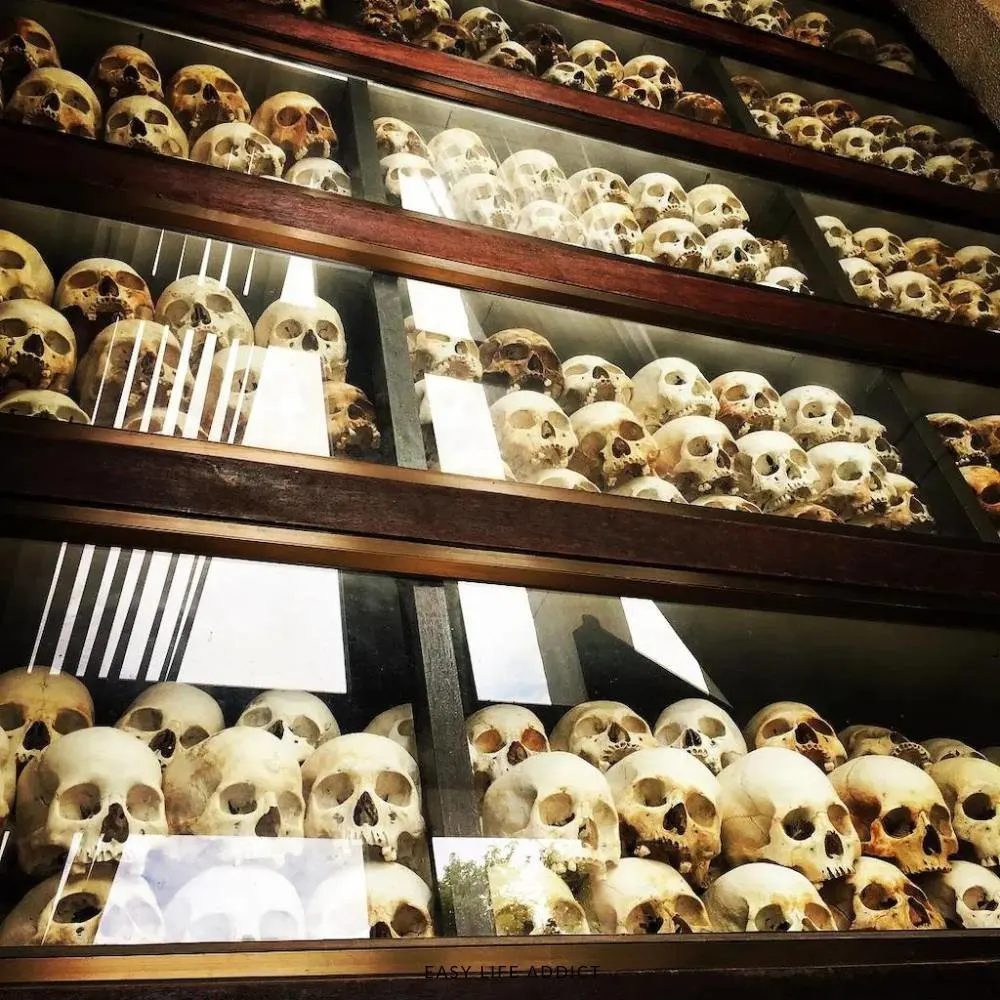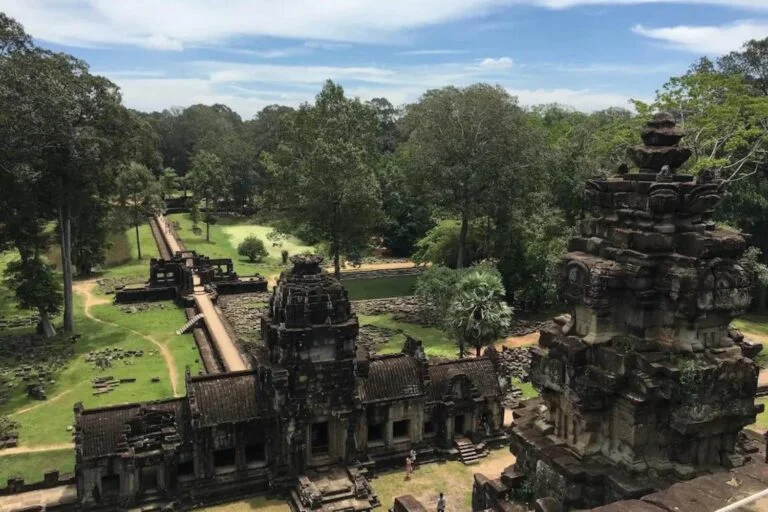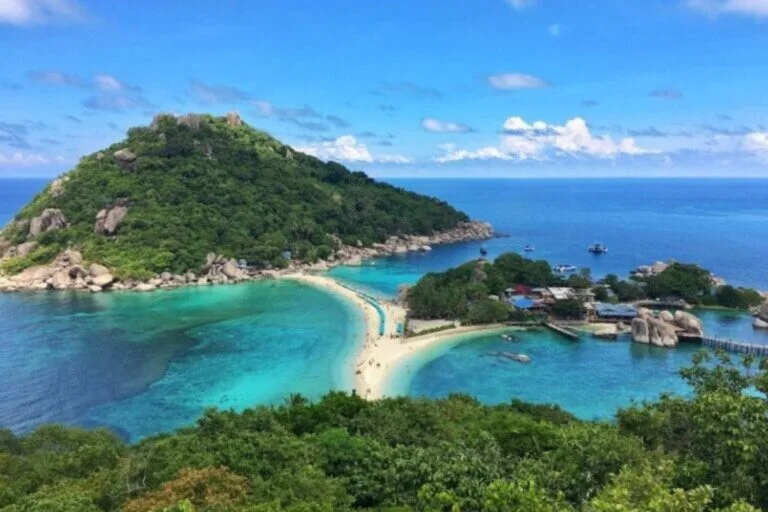Visiting The S21 Museum And Killing Fields In Phnom Penh!
It’s not often that you get to experience such an emotionally charged environment, but visiting the Tuol Sleng Genocide Museum and its associated Killing Fields is an opportunity no visitor to Cambodia should miss. Located in Phnom Penh, this museum complex commemorates one of the darkest times of recent history in Cambodia, the Khmer Rouge Regime from 1975-1979, a time when millions upon millions of innocent people lost their lives or were forced into cruel labour camps.
Through paying homage at S21 (formerly a high school used as a torture centre) and exploring the many gravesites which make up The Killing Fields of Choeung Ek, visitors gain first-hand insight into these horrific events and can bear witness to some small part of this nation’s brutal past.
This post may contain affiliate links. That means that if you click on a link and purchase something I recommend, I will receive a small commission at no extra cost to you. As an Amazon Associate, I earn from qualifying purchases. This helps keep my website up and running and is very appreciated. Thank you for your support! You can read my full disclosure policy here.
Cambodia has to be one of my favourite countries to visit. It may not be as commercialised, touristy or have the same infrastructure as its neighbours, Thailand or Vietnam, but this is what sets it apart!
Cambodia is full of history and culture. You can walk around the towns and cities and be welcomed by local shops, restaurants, and friendly locals. If you are looking for an authentic travel experience, Cambodia will not disappoint!
Phnom Penh, the capital of Cambodia, is no exception. The city is crazy and bustling with mopeds, tuk-tuks, cars, vans and buses, all tousling for the right of way. Traffic is crazy, and you will often see people taking no notice of road signs or traffic lights and even driving down the street on the wrong side of the road!
I’ve seen mopeds with four or five people squashed on and many carrying young babies! Don’t let this put you off, though; just be prepared for lots of beeping! However, unlike Siem Reap, Phnom Penh hides a dark past!
The fact that Cambodia seems to be 20 years behind other countries in the area is generally due to the horrific and tragic events that took place during the reign of the Khmer Rouge led by Pol Pot from 1975 to 1979.
During this time, it is estimated that up to 2 million Cambodians died of starvation, execution, disease or overwork. The Khmer Rouge attempted to engineer a classless communist society and took a particular disdain for intellectuals, city residents, ethnic Vietnamese, civil servants and religious leaders.
Immediately after taking control of Phnom Penh, the Khmer Rouge evacuated its 2.5 million residents, stripped them of their belongings and made them toil in the fields as part of a re-education program.
The Khmer Rouge renamed Cambodia to the Democratic Kampuchea, and under Pol Pot’s new regime, the state controlled all aspects of a person’s life; children were taken from their families and made to join the military.
Anybody who disagreed or complained about the new regime was usually tortured and sent to detention centres, such as the infamous S-21, now known as the Tuol Sleng Genocide Museum, and killed. Of the estimated 20,000 people imprisoned at S-21, there were only 12 known survivors! Many of the bodies of those killed were buried in mass graves known now as the killing fields.
A visit to the killing fields and the S-21 museum is a must-do when visiting Phnom Penh; however, is it not a pleasant experience! Both museums give insight into the atrocities at that time and give you a very sobering experience. At times, I was overwhelmed with emotion, but it is essential to learn about such events in the hope that these atrocities and suffering don’t happen again. However, it’s sad to know that this was not the last genocide the world has experienced and that in some places around the world, these things are still happening now!
Tuol Sleng Genocide Museum: S-21 Museum:
The S-21 detention centre was one of many in Cambodia and was formerly the Chao Ponhea High School. However, in 1976, it was turned into a prison and interrogation centre and renamed Security Prison 21.
It is thought that there were as many as 1500 prisoners there at any one time who were repeatedly tortured and coerced into giving details of other family members or close associates who were then, in turn, arrested, tortured and killed themselves.
Most of the victims of S-21 were soldiers from the previous regime, government officials, academics, doctors, teachers, monks, and virtually anyone who was seen to be an intellectual.
The prison had stringent rules, and most prisoners were held there for up to 3 months; during this time, the torture system was designed to make prisoners confess to whatever crimes they were charged with, regardless of whether it was true or not, after which they were then killed.


In the beginning, most prisoners who were killed were buried near the prison, but eventually, they ran out of space. This meant that prisoners were then transported out of Phnom Penh to what is now known as the Killing Fields, where they were executed and put into mass graves. Although the majority of those killed were Cambodian, there were many foreign nationals, including some Westerners.
The S-21 museum can be easily reached by foot from the city centre, and the entrance fee is only $5; you can also get an audio guide for an extra $5, which I recommend.
As you enter the museum, you can easily imagine what the site was like when it was a school. Within its typical square layout, the large courtyard in the middle, you can imagine the children running around playing. However, as soon as you get to the first point on the audio guide, you are right away transported back to reality and the atrocities that have taken place!



At times, I found it very difficult to read all the displays as the amount of information and graphic detail was so intense. To be honest, as we visited the Killing Fields beforehand, I left the museum before seeing all of it as, by that time, I just couldn’t take any more in. Doing both museums back to back is a very tough experience; if you have the time, I recommend visiting them over two separate days.
The museum also plays documentaries, including survivor stories, detailed accounts, photos, and original fixtures. There is also a gift shop; some days, you will find one of the survivors who has a bookstall.
The S-21 museum is open daily from 8 am – 5 pm.
Choeung Ek, The Killing Fields:
The Killing Fields Memorial at Choeung Ek is located about 17 kilometres from Phnom Penh. An entrance fee is $3, with a must-have audio guide for another $3. The audio guide here is brilliant and helps you understand the site and the details of what happened. The only transport to the site is by tuk-tuk, which you can hire for about $20 for the day.

The site used to be a Chinese cemetery and orchard, and you can still see signs of it today. It is thought about 20,000 men, women and children were killed here and then dumped into one of the many mass graves.
The site itself is just one of many found ‘killing Fields’ around Cambodia. Many victims had previously been tortured in one of the many security prisons, such as S-21 and were brought here to be executed. However, to save on bullets, they killed in the cheapest way possible, usually bludgeoned or hacked to death or by using the sharp leaves of the surrounding trees to slit people’s throats.
The audio guide takes you from point to point, painting a picture of what happened here and explaining what it would have looked like. As you walk around the site, you will see many coloured bracelets left as a mark of respect; you will also walk around areas of mass graves, many of which have not been unearthed. As you walk around, you may come across items of clothing or pieces of bone which have found their way to the surface due to heavy rainfall.



Some points of the tour can be very harrowing, especially the points where it is known that executioners beat and killed children and babies.
The most poignant part of the tour is towards the end when you come face to face with the large stupa containing thousands of sculls as well as items of clothing and weapons used to kill. There are many parts of the tour where you can sit, reflect, and listen to some of the personal stories in the audio guide.
The Choeung Ek memorial is open daily from 8 am – 5 pm
Final Thoughts
A visit to the Tuol Sleng Genocide Museum and the Killing Fields is a sobering experience that should not be missed. It is a powerful reminder of the atrocities that can be committed when hatred and fear are allowed to run rampant. These sites stand as a testament to the strength and resilience of the Cambodian people, who have overcome unimaginable suffering. If you are in Phnom Penh, do not miss out on this moving experience.
Read more: Exploring Angkor Wat, Cambodia’s ancient temples!
Thanks so much for stopping by; I appreciate everyone who takes the time to read and make it to the end! I have lots of exciting new content in the next few weeks, so make sure you pop back to catch up!
Remember to follow our social media accounts for more travel inspiration and updates.
Happy travels!






